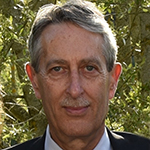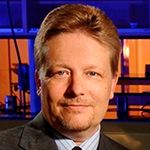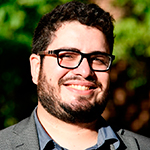The ECS Society Awards will be presented during this meeting at the Plenary Session. The Olin Palladium Award will be presented to Philippe Marcus, Centre National de la Recherche Scientifique – Ecole Nationale Supérieure de Chimie de Paris (CNRS-ENSCP) and the Carl Wagner Memorial Award will go to Eric Wachsman, University of Maryland.
Mark Burgess and Kenneth Hernández-Burgos from University of Illinois at Urbana-Champaign will recieve the Norman Hackerman Young Author Award for best paper published by young authors in the Journal of The Electrochemical Society. Peng Sun from University of Michigan will receive the Bruce Deal & Andy Grove Young Author Award for best paper published by a young author in the ECS Journal of Solid State Science and Technology.
 Olin Palladium Award
Olin Palladium Award
of The Electrochemical Society
Tuesday, Oct. 3 | 1810h
Camelia 3
Corrosion Mechanisms at the Atomic or Nanometric Scale
By Philippe Marcus
Philippe Marcus is the director of research at CNRS (National Centre for Scientific Research) and head of the research group of physical chemistry of surfaces at the Institut de Recherche de Chimie Paris, at Chimie ParisTech, France. Marcus received his PhD (1979) in physical sciences from University Pierre and Marie Curie, Paris, France. His field of research is surface electrochemistry and corrosion science, with emphasis on understanding the relationship between structure and properties of metal surfaces and oxide films at the atomic or nanometric scale.
Marcus has received the Corrosion Division H. H. Uhlig Award (2005) from The Electrochemical Society, Whitney Award (2008) from NACE International, Cavallaro Medal (2008) of the European Federation of Corrosion, U.R. Evans Award (2010) of the UK Institute of Corrosion, and the Lee Hsun Award of the Institute of Metals Research (2012) of the Chinese Academy of Sciences. He is a fellow of The Electrochemical Society (2005) and of the International Society of Electrochemistry (2009). He is currently chairman of the EFC Working Party on Surface Science and Mechanisms of Corrosion and Protection, chairman of the International Steering Committee for the European Conferences on Applications of Surface and Interface Analysis, and vice president of CEFRACOR (French Corrosion Center).
 Carl Wagner Memorial Award
Carl Wagner Memorial Award
of The Electrochemical Society
Tuesday, Oct. 3 | 1010h
National Harbor 7
Mixed Protonic-Electronic Membrane Reactors; Converting Hydrocarbon Resources and CO2 to Fuels
By Eric Wachsman
Eric D. Wachsman is the director of the Maryland Energy Innovation Institute and Crentz Centennial Chair in Energy Research, with appointments in both the Department of Materials Science and Engineering and the Department of Chemical Engineering at the University of Maryland. Wachsman is a fellow of both The Electrochemical Society and the American Ceramic Society and serves on the ECS Board of Directors.
In addition, he is the editor of Ionics; on the editorial board of Scientific Reports, Energy Systems, and Energy Technology; and a member of the American Chemical Society, the International Society for Solid State Ionics, and the Materials Research Society. His research is focused on solid ion-conducting materials and electrocatalysts, and includes the development of solid oxide fuel cells, solid state batteries, ion-transport membrane reactors, and solid state gas sensors. He has more than 250 publications and 17 patents on ionic and electronic transport in materials, their catalytic properties, and device performance.
 Norman Hackerman
Norman Hackerman
Young Author Award
Scanning Electrochemical Microscopy and Hydrodynamic Voltammetry Investigation of Charge Transfer Mechanisms on Redox Active Polymers
By Mark Burgess
Mark Burgess completed his undergraduate studies at the University of Utah, where he received a BS in chemistry, with an emphasis in chemical physics in May 2013. While at the University of Utah, he performed undergraduate research under the direction of Henry S. White concerning finite element modeling of nano-electrochemical cells. Burgess continued his studies in electroanalytical chemistry by pursuing a PhD at the University of Illinois at Urbana-Champaign, working under the guidance of Joaquín Rodríguez-López. While at Illinois, Burgess’ research has centered on characterizing the electrochemical dynamics of soluble redox active polymers in conjunction with research efforts sponsored by the Joint Center for Energy Storage Research.
Burgess has broad research interests, but he has specialized in advanced electroanalytical analysis using scanning electrochemical microscopy to study soluble redox active macromolecular systems. Burgess has been recognized with many professional honors including a National Science Foundation Graduate Research Fellowship and a Department of Energy Graduate Student Research Award.
 Norman Hackerman
Norman Hackerman
Young Author Award
Scanning Electrochemical Microscopy and Hydrodynamic Voltammetry Investigation of Charge Transfer Mechanisms on Redox Active Polymers
By Kenneth Hernández-Burgos
Kenneth Hernández-Burgos earned a BA in chemistry from the University of Puerto Rico at Río Piedras (UPR-RP) in 2010. During his time at UPR-RP, he was a Minority Access for Research Careers Fellow and investigated the electrochemical and spectrochemical properties of ferrocene derivatives under the supervision of Ana R. Guadalupe. He earned his PhD at Cornell University, where he was advised by Héctor D. Abruña. During that time, he mastered the design and characterization of organic electrode materials for electrical energy storage applications.
Currently Hernández-Burgos is a Beckman Fellow at the University of Illinois at Urbana-Champaign, where he is conducting his research, to the design and characterization of redox-active polymers (RAPs) for redox flow batteries, in the Joaquín Rodríguez-López lab.
 Bruce Deal & Andy Grove
Bruce Deal & Andy Grove
Young Author Award
Toward Practical Non-Contact Optical Strain Sensing Using Single-Walled Carbon Nanotubes
By Peng Sun
Peng (Patrick) Sun is a postdoctoral research fellow in the Department of Civil and Environmental Engineering at University of Michigan, Ann Arbor. His research focus is on the creation of smart sensing technologies using microelectromechanical systems (MEMS) and nanotechnology, as well as the application of smart sensing systems and algorithms in structural health monitoring and damage identification. He is particularly interested in combining knowledge in civil engineering and other disciplines to convert traditional structures into more intelligent systems through the integration of sensing.
Sun obtained his PhD from Rice University in May 2017. His PhD study was focused on developing a novel, noncontact, full-field, strain sensing technology. He received his MS (2012) and BS (2009) in earthquake engineering and civil engineering, respectively, both from Southeast University in China, where he carried out investigations on system identification and signal processing using structural vibration.




